Memory Scaling on Haswell CPU, IGP and dGPU: DDR3-1333 to DDR3-3000 Tested with G.Skill
by Ian Cutress on September 26, 2013 4:00 PM ESTOur final set of tests are a little more on the esoteric side, using a tri-GPU setup with a HD5970 (dual GPU) and a HD5870 in tandem. While these cards are not necessarily the newest, they do provide some interesting results – particularly when we have memory accesses being diverted to multiple GPUs (or even to multiple GPUs on the same PCB). The 5970 GPUs are clocked at 800/1000, with the 5870 at 1000/1250.
Dirt 3: Average FPS
It is pretty clear that memory has an effect: +13% moving from 1333 C9 to 2133 C9/2400 C10. In fact, that 1333 C9 seems to be more of a sink than anything else – above 2133 MHz memory the performance benefits are minor at best. It all depends if 186.53 FPS is too low for you and you need 200+.
Dirt 3: Minimum FPS
We see a similar trend in minimum FPS for Dirt3: 1333 C9 is a sink, but moving to 2133 C9/2400 C10 gives at least a 20% jump in minimum frame rates.
Bioshock Infinite: Average FPS
While differences in Bioshock Infinite Minimum FPS are minor at best, 1333 MHz and 1600 C10/C11 are certainly at the lower end. Anything 1866 MHz or 2133 MHz seems to be the best bet here, especially in our case if we wanted to push for 120 FPS gaming.
Bioshock Infinite: Minimum FPS
Similar to Bioshock on IGP, minimum frame rates across the board seem to be very low, with minor differences giving large % rises.
Tomb Raider: Average FPS
Tomb Raider remains resilient to change across our benchmarks, with 1 FPS difference between the top and bottom average FPS results in our tri-GPU setup.
Tomb Raider: Minimum FPS
With our tri-GPU setup being a little odd (two GPUs on one PCB), Tomb Raider cannot seem to find much consistency for minimum frame rates, showing up to a 15% difference when compared to our 1600 C10 result which seems to be a lot lower than the rest.
Sleeping Dogs: Average FPS
Similar to other results, 1333 and 1600 MHz results give lower frame rates, along with the slower 1866 MHz C10/C11 options. Anything 2133 MHz and above gives up to 8% more performance than 1333 C9.
Sleeping Dogs: Minimum FPS:
Minimum frame rates are a little random in our setup, except for one constant – 1333 MHz memory does not perform. Everything beyond that seems to be at the whim of statistical variance.


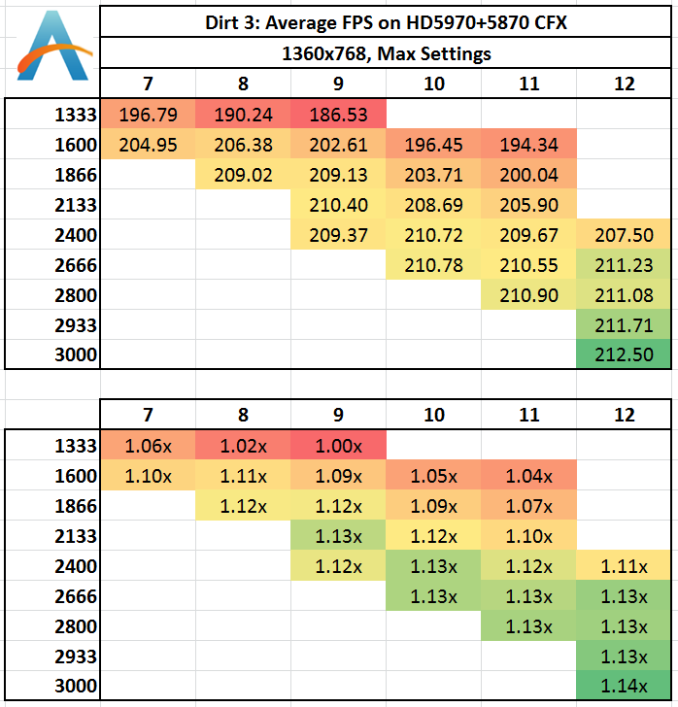
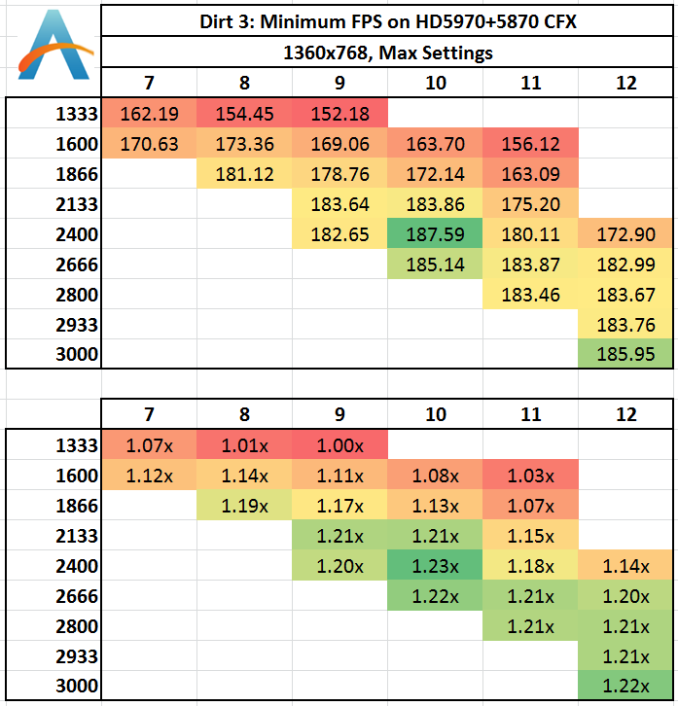

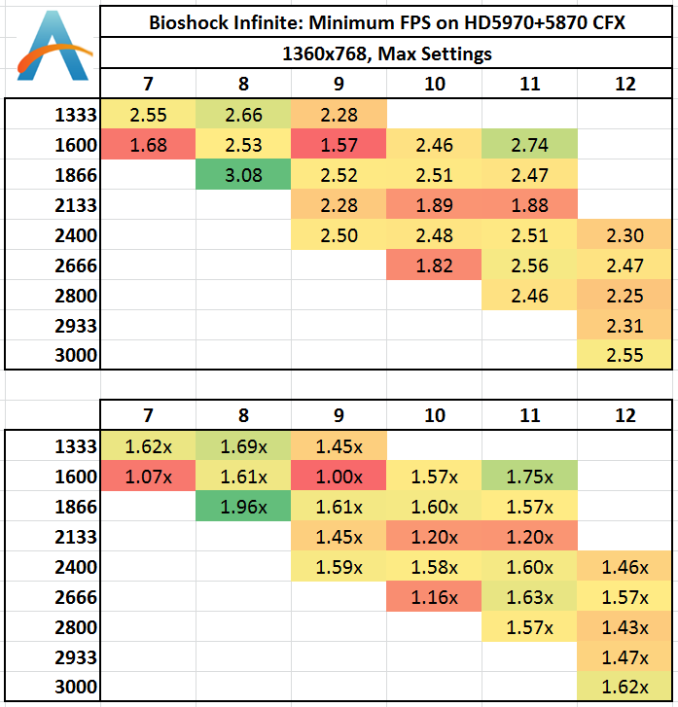
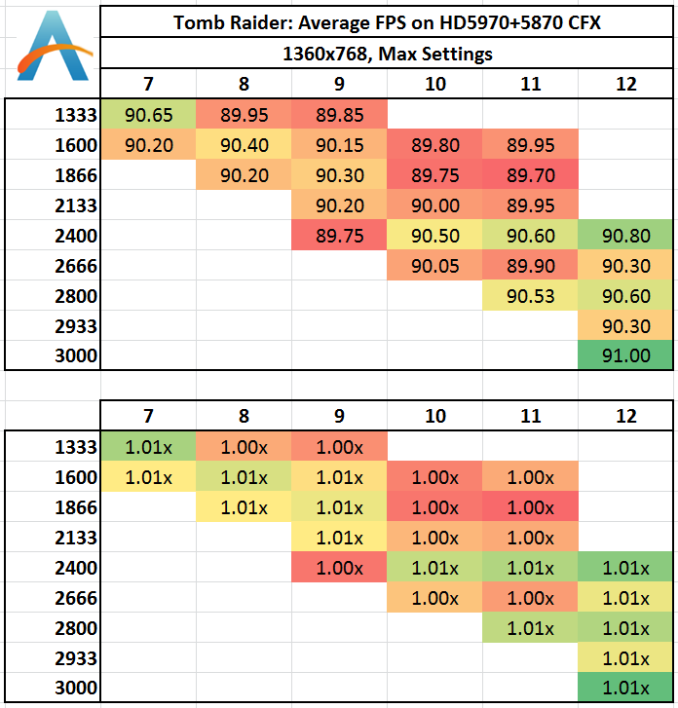

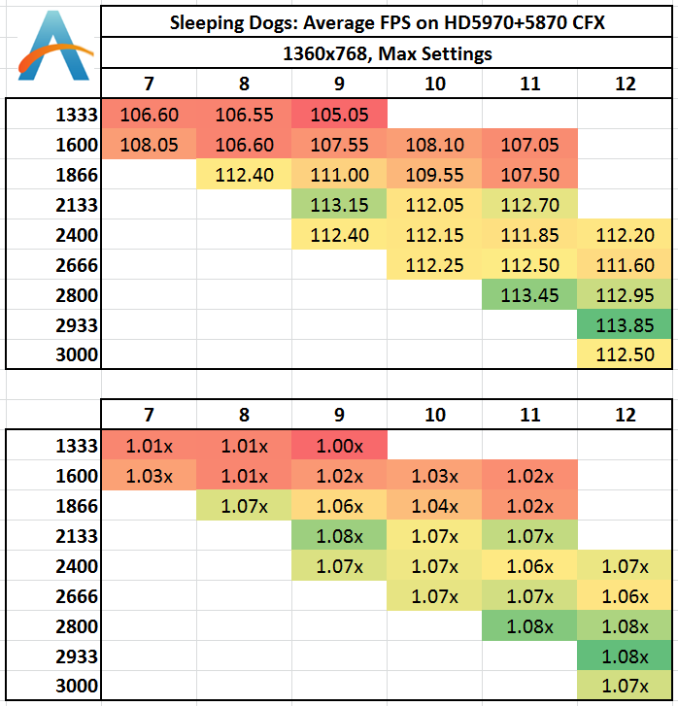
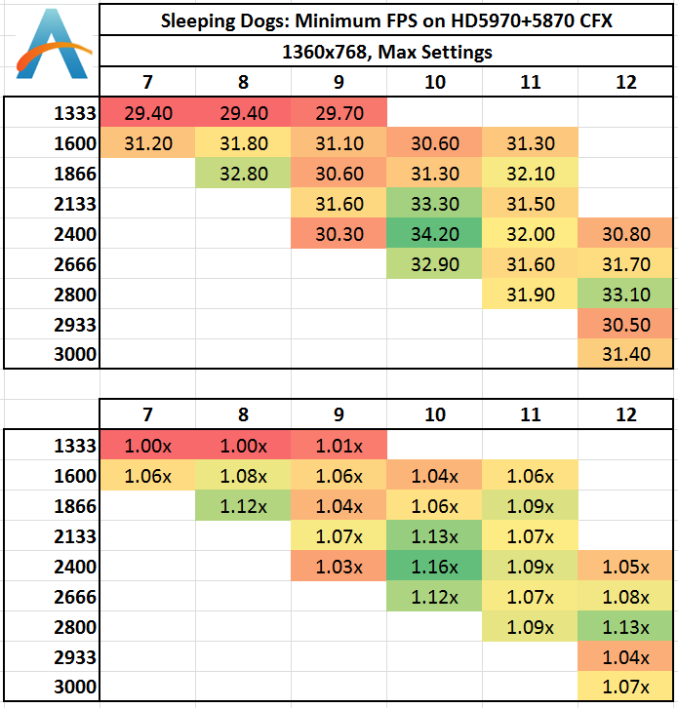








89 Comments
View All Comments
HerrKaLeun - Saturday, September 28, 2013 - link
This was a good review. But I see one major problem for practiacl applications:Whoever cares about performace, doesn't use 8 GB of memory in the year 2013.
Even for a cheap home-built (no gaming, no CAD etc.) I used 16 GB a year ago, which cost only ~$70. when I run multiple applications in parallel (who doesn't?) W7/8 easily uses all memory for cache. Even with an SSD this is a speed advantage.
So for real world applications (running virus scan in parallel to work, 18 browser windows, watching movies etc) 8 GB re easily used up.
I would imagine a 16 GB PC (let's say ~$100) runs circles around the $700 8 GB PC in the real world.
Right now I run MSE and Malwarebytes while just using IE for browsing and I have none of my 16 GB left. The computer is not sluggish at all. I'm not sure how 8 GB RAM would work out.
One could argue most applications don't require that much memory, but running virusscan frequently should be done by all users.
I think this test should be repeated with either 16 GB or 24 GB for triple-channel platform. People interested in a few % more, also need more RAM.
Wwhat - Sunday, September 29, 2013 - link
@HerrKaLeun you say who doesn't use more than 8GB? and say you got 16GB for about 70 dollars, but this article covers a lot of extremely highly speced RAM that as stated is quite expensive, and if you bought 8GB for several hundred dollars you aren't going to supplement it with cheap high-latency low speed off-the-shelf stuff obviously.malphadour - Sunday, September 29, 2013 - link
HerrKaleun you are talking rubbish!! I have an X58 running 6gb ram and I never get anywhere near flooding it. 8GB is more tha ample for 99% of users out there. I recently built a 16gb ram rig for one of our engineers because he demanded it. To prove a point I benchmarked all our software (which includes a juicy construction CAD package) and recorded no more than a 3% performance increase going to 16gb and I put most of that down to going from single channel 8gb stick to dual channel for the 16gb. We tested render times, large drawing copies plus program open and close times with lots every peice of software on the machine running. His argument was the same as yours, and incorrect. Hardware is way ahead of the curve at the moment vs software and it will be a while before the everyday user "needs" more than 8gb.Wwhat - Monday, September 30, 2013 - link
To be fair, I hear battlefield 4 has as suggested setup at least 8GB.Like always the more RAM people on average have the more software starts to require.
ShieTar - Monday, September 30, 2013 - link
"So for real world applications (running virus scan in parallel to work, 18 browser windows, watching movies etc) 8 GB re easily used up."Because Windows will fill up all the Memory it has before even starting any garbage collection algorithms. Even today, you should be able to do all those trivial applications on 2GB of memory.
And anybody doing serious work or gaming will probably not run two major software packages at the same time. A few background programs (depending on how paranoid your companies IT department is), and a few trivial programs like browser, word processor, excel, PDF may run on the side and use up 1GB to 2GB. But nobody in his right mind will start processing of huge images in Photoshop while keeping his CAD models open in CATIA. A few nutjobs out there may run 16 installations of WoW on 16 screens with the same PC, but thats not really relevant to a general review.
So if you go and have a look again at what is tested in this review, and once you understand that any reviewer worth his salary will not go and run a dozen pieces of software parallel to the one software he is benchmarking at that moment, it should be clear at the very least that repeating above benchmarks with 16GB will give you absolutely no difference in the benchmark results whatsoever.
Chrispy_ - Sunday, September 29, 2013 - link
So the the three common scenarios are::
--- 1. You want an IGP ---
Get the cheapest RAM, If you buy significantly better RAM the cost of APU + RAM becomes more than the cost of a normal CPU + dGPU + cheap RAM, which is obviously much higher.performance.
:
--- 2. You want a single graphics card ---
Spend the money you're *thinking* about spending on better RAM on a better graphics card. If you want a decent dGPU then you're most likely a gamer and even 1600MHz CL9 is fine, but you'll see a big improvement if you move from a $200 GTX660 to a $250 660Ti
:
--- 3. You want more than one graphics card ---
Divide RAM Frequency by CAS Latency to get the actual speed, I've been doing this for years and I'm glad Ian has finally mentioned this in an article.
ShieTar - Monday, September 30, 2013 - link
I don't think anybody would disagree with the general direction of your comment, but you seem to overestimate the exact differences in cost for 8GB of RAM these days. A quick check (for Germany) gives me the following price differences for RAM frequency (relative to 1333):1600 : -0.50€ (No-Brainer)
1866 : +1€
2000 : +20€
2133 : +10€
2400 : + 8€
2666 : +50€
2933 : +170€
So, for 8€ you can pick 2400 instead of 1600, which would give you a significant increase in performance should you ever find a piece of software that heavily depends on memory transfer rates. You are very unlikely to step up your CPU or GPU model for that kind of price difference.
Latencies can be similar. For DDR3-1600, going from CL11 to CL9 will cost you about 2€ to 3€. Of course, at that point you still have a higher latency than DDR3-2400 with a CL11, so that seems to make the most sense right now for price to value ratio.
rootheday3 - Sunday, September 29, 2013 - link
Hd4600 is likely not memory bottlenecked with 20 eus at stock igp frequencies. There is a reason that intel didn't add the EDram to skus other than the 47w+ gt3e 40eu skus, 4 samplers and 2pixel hacienda. For a gt2 with half the assets, memory is not the issue- 1600mhz in dual channel is plenty. For people who were asking earlier in the thread, dual channel vs single channel is ~15-30% impact on gt2.If you want to see more sensitivity/ scaling with memory, you would need to OC the igp first.
Or, as others said, test on skus that are more likely to stress memory - like gt3e (iris pro 5200) Note that hd5000 (15w package tdp) and iris 5100 (28w tdp) may be tdp bound on most workloads, so even there you may not see scaling with memory beyond ~1600-1866 dual channel.
Note that Trinity/Richland are more sensitive to memory (especially on 65-100w desktop skus) because they don't have the LLC to buffer some of the bandwidth demands.
malphadour - Sunday, September 29, 2013 - link
I have mushkin 6-8-6-21 1600mhz which seems to be almost unique (don't think I have seen nayone else make cl6 at this speed) - would be interested to see if CL6 at 1600mhz was a match for much higher mhzmalphadour - Sunday, September 29, 2013 - link
I think the comment 1600mhz is bad can be taken with a pinch of salt here. Depends on who the PC is for. If it is normal use then 1600mhz cl9 is going to be fine all day long. Ian's point is, I think, aimed at the enthusiast who is benchmark chasing, in which case bigger is always better. It would be nice if hte price of ram had not doubled. I was buying 8gb 1600mhz cl9 for £29.99 not too long ago, two recent builds it is as £54.99, nearly twice the price in the UK :(